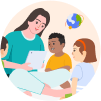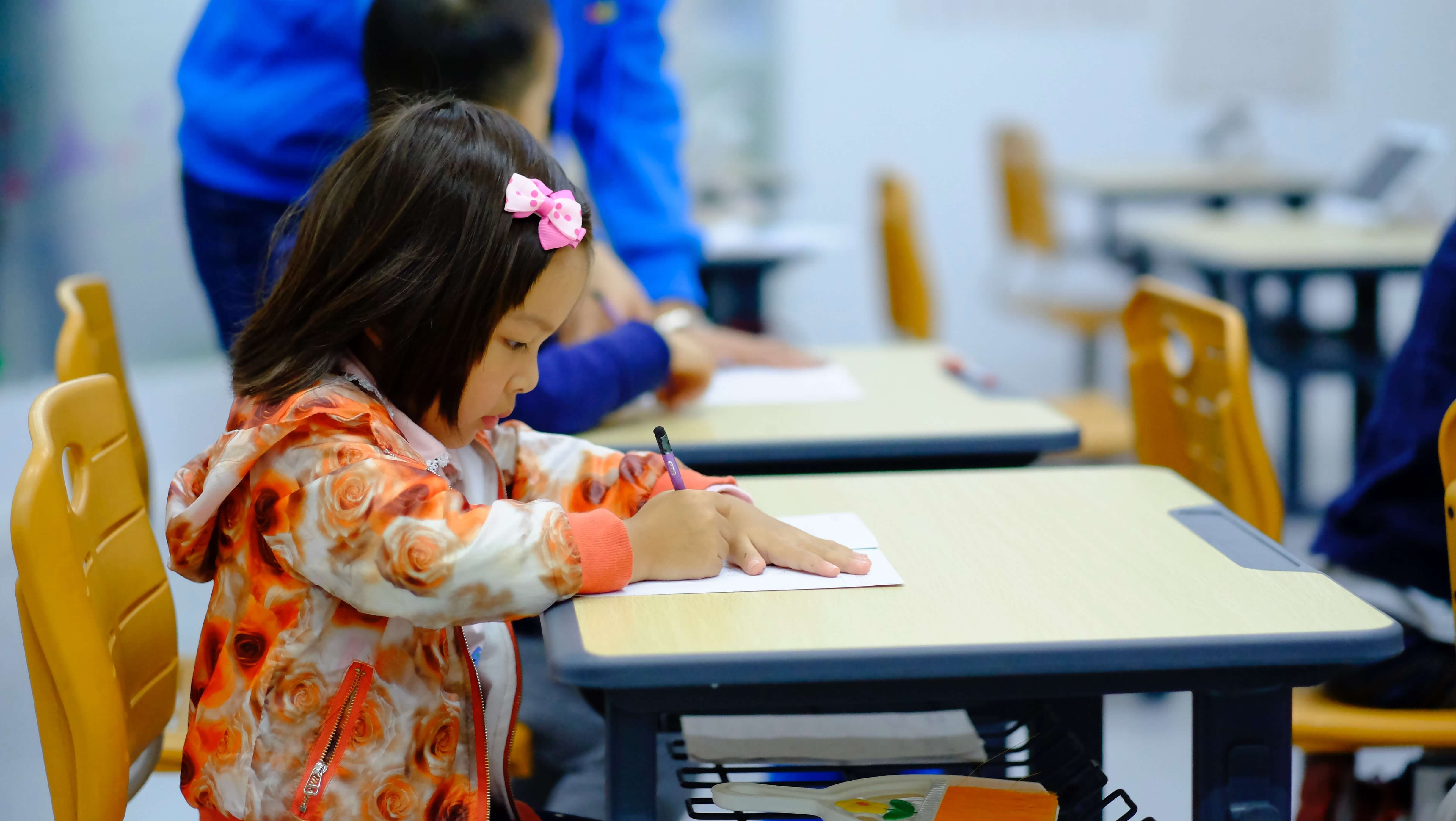Head Start School Readiness Goals Prepare Children for School
You may be familiar with the federal Head Start program as a parent or educator, but do you know what the school readiness goals are? Head Start is all about preparing underserved young children for school, so having Head Start school readiness goals is essential.
Head Start and other preschool programs help young children develop the learning skills, cognition, physical and motor skills, and social and emotional readiness to be successful in kindergarten and beyond.
To ensure that programs deliver on these promises, Head Start requires goal setting for school readiness. Based on research and child development, the goals are flexible but also guided.
Learn more about Head Start school readiness goals and what it means for participants, parents, and educators.
What is School Readiness?
Head Start defines school readiness as “children possessing the skills, knowledge, and attitudes necessary for success in school and for later learning and life.”
In other words, it sets the standard for a child to be ready to succeed in school but also later in life. School readiness is a broad sweep with several components:
- Child readiness. Children are ready for school when they meet certain standards and goals for learning, social and emotional development, language and literacy, cognition, and motor, physical, and perceptual development.
- Family readiness. Children develop skills and knowledge to succeed in school, but they also rely on their families. School readiness includes families that are prepared to support their children’s learning and academic success.
- School readiness. Schools are obviously a big part of the picture of overall readiness. With prepared children and supportive families in place, schools must be ready to educate students and set them up for success.
The Importance of School Readiness
Being ready for anything is clearly crucial to success. If a child cannot self-regulate or interact well with others, they will struggle to succeed in a classroom environment. The more prepared children are for school, the more likely they are to succeed in several measures.
Speaking strictly about academics, studies show that school readiness is vital to later success. One study looked at several elements of school readiness and found that they all matter in terms of later success. Those that best predict actual readiness based on academic success include math, reading, and attention skills.
Preschool programs like Head Start address these crucial measures—and several others—to prepare children for school. Studies have shown these model preschool programs positively affect several measures that indicate they do, in fact, prepare students for school. This is as compared to students who did not participate in a model program before kindergarten.
The most significant of these positive benefits is high school graduation rates. Also improved by Head Start and preschool participation:
- Self-regulation
- Grade retention
- Appropriate placement in special education services
- Teenage pregnancy rates
- Criminality
- Later employment and income
This is why it’s so important for Head Start to require programs to develop Head Start school readiness goals. The more prepared children are for school, the more likely they are to succeed later. The benefits of school readiness programs spill over into the community too.
The Role of Head Start in School Readiness
Head Start plays a big role in school readiness. It serves children with particular vulnerabilities, like poverty and housing instability. Children from more stable, higher-income families have access to school readiness programs that these others do not.
Several studies show that academic achievement gaps between vulnerable children and others exist. The gaps center mostly on income level, but also race and ethnicity and housing instability. Closing those gaps means providing vulnerable populations with greater access to quality early learning and preschool.
Because Head Start plays such a big part in preparing vulnerable children, it requires individual programs to set school readiness goals. Head Start provides guidance. It also allows individual programs to develop the goals that work best for their communities. Schools must remain within a certain framework but also have flexibility to meet the needs of their students and families.
Head Start School Readiness Goals and Requirements
Program standard number 1302.102 (achieving program goals) states that programs must develop a school readiness plan for Head Start students. This includes creating measurable objectives and goals. Four main components apply to Head Start school readiness goals:
- Establishing program goals. With guidelines set by Head Start, and in conjunction with the appropriate state agency, programs must establish school readiness goals.
- Monitoring program performance. As part of ensuring a program serves students adequately, it must continue to assess the goals. This means using self-assessments to make sure students are achieving Head Start school readiness goals. It also includes working with families, staff, and agencies to assess goals.
- Using data for continuous improvement. Programs must collect and use data to improve their operations and services. This includes using data to assess and adapt Head Start school readiness goals as needed.
- Reporting. Finally, programs have to send status reports semiannually to the governing agency. Reports include all kinds of factors, including the assessment of goals and any deficiencies found.
The Head Start Early Learning Outcomes Framework
Head Start gives individual programs the flexibility to create goals that align best with the needs of their students and community. It does, though, provide an important framework for crafting appropriate and effective goals.
Known as the Head Start Early Learning Outcomes Framework, it covers essential areas of development from birth to age five. The Framework includes an infant and toddler version for children up to age three, and a preschool version.
What is the Learning Outcomes Framework?
Head Start created the framework to describe the knowledge, skills, and emotional and behavioral readiness the program aims to develop in all children who graduate the programs. The most recent version is published as the Head Start Early Learning Outcomes Framework: Ages Birth to Five.
The point of the framework is to provide guidance for individual programs. It should describe everything all children need to be ready for school. This includes children living with disabilities and dual language learners.
Head Start programs should use the framework to create learning experiences, develop curricula, lead professional development, and prepare school readiness goals. It is based on the most current child development and educational research.
How Programs Use the Framework to Set School Readiness Goals
The framework is evidence-based, which means it serves as the best and most comprehensive guide for program plans. It outlines what children should be able to do, especially in preparation for school. This serves as the basis for Head Start school readiness goals and encourages consistency across programs.
The framework includes several guiding principles that must be considered when creating Head Start school readiness goals:
- Every child can succeed and is a unique learner. Each child develops differently and at their own pace. All kinds of outside forces shape how and when they learn. Goals are set for all students, but they need varying degrees and types of support to meet them. All children can meet these goals.
- Learning involves relationships. Learning doesn’t happen in a vacuum. To meet goals, children need supportive relationships with educators, staff, parents, and other adults.
- Families are the first teachers. A child’s family and home environment are essential to their learning and development. Goals must align with the primacy of the family in a child’s life. Programs must respect families and their knowledge, backgrounds, and cultures.
- Children must be safe to learn. All children can meet the readiness goals, but issues of security may hamper their learning and development. Head Start programs must be safe places where children feel comfortable and valued.
- Every learning goal integrates with the others. Young children learn new skills and behaviors, not one at a time but in an overlapping manner. Each goal connects to or intersects with one or more other goals.
- Teaching practices are child-focused. Educators must understand how children learn and develop, and then adapt their practices accordingly. Young children learn readily and eagerly, not just through instruction but also through play and by exploring their environments.
- Children’s strengths reflect diversity. Children in Head Start come from all kinds of backgrounds and cultures. Programs and goals must respect this diversity and recognize the inherent strengths and learning needs of each student.
Using these guiding principles and the five domains of school readiness, Head Start programs craft appropriate school readiness goals for all their students.
The Five Domains Used to Establish Head Start School Readiness Goals
The bulk of the Framework published for Head Start are the descriptions of the five domains and their subdomains. These outline what preschool children should know, be able to do, and how to behave in order to be prepared for school success:
| Domain | Sub-Domains | Description |
| Approaches to Learning | Emotional and behavioral self-regulationCognitive self-regulation (executive functioning)Initiative and curiosityCreativity | The Approaches to Learning domain describes how children learn to self-regulate their emotions, behaviors, and thinking and learning. This includes things like following class rules, developing independence, and controlling impulses. |
| Social and Emotional Development | Relationships with adultsRelationships with other childrenEmotional functioningSense of identity and belonging | This domain is all about relationships and managing and responding to emotions. Children must learn to interact and cooperate with adults and develop positive relationships with other kids. They learn to express emotions appropriately and become part of a community. |
| Language and Literacy | Attending and understandingCommunicating and speakingVocabularyPhonological awarenessPrint and alphabet knowledgeComprehension and text structureWriting | Language and literacy describes how young children begin to learn to communicate with others, learn new words, recognize text, write, and read. Self-expression is also an important part of this domain. |
| Cognition | Counting and cardinalityOperations and algebraic thinkingMeasurementGeometry and spatial senseScientific inquiryReasoning and problem-solving | The cognition domain refers to how a child learns to reason, think, solve problems, and remember things. It also includes math skills, like counting, patterns, and measurement. |
| Perceptual, Motor, and Physical Development | Gross motorFine motorHealth, safety, and nutrition | The final domain describes the physical development of a young child. It includes large muscle use as well as fine motor skills, such as holding a pencil. This domain also addresses health and safety, including nutrition and hygiene. |
School Readiness Goals for Early Head Start
Early Head Start Programs use the same framework and domains to establish school readiness goals. The readiness, of course, is not for kindergarten, but establishes how children develop from infancy to age three. The framework represents a continuum along which children progress to eventually be ready for school.
Early Head Start also uses many of the same subdomains, with different expectations of course. A few of the subdomains differ for early Head Start readiness goals:
- Approaches to Learning. The subdomains are the same as for the preschool framework.
- Social and Emotional Development. All of the social and emotional development subdomains are also the same for both early and preschool Head Start.
- Language and Literacy. This domain is called Language and Communication for infants and toddlers. It includes a subdomain for emergent literacy to reflect how these younger children learn language: through hearing stories, recognizing symbols, handling books, repeating phrases, and finding meaning in stories and pictures.
- Cognition. The cognition subdomains for youngsters include exploration and discovery, memory, reasoning and problem solving, emergent mathematical thinking, and imitation and symbolic representation and play. For babies and toddlers, cognition is all about exploring, symbolic play, and just beginning to make connections.
- Perceptual, Motor, and Physical Development. In this domain, babies and toddlers have an additional subdomain for perception. At this age, they develop an understanding of the world around them through their senses and perceptions. This information begins to direct what they do and how they interact with objects and people.
Goals and Objective Examples for School Readiness for Head Start
The framework provides an important starting point for Head Start programs to develop school readiness goals. They have flexibility to make these goals work for the unique needs of their communities, families, and students.
These are some examples of readiness goals created using the framework as a guide:
| Domain | Goal | Examples |
| Approaches to Learning | Children will demonstrate initiative, independence, interest, and curiosity in interactions with others and exploration of objects and people in their environment. | Gathering art supplies to draw a picture or make a craftTrying new games with classmates |
| Social and Emotional Development | Children will appropriately express and respond to a broad range of emotions, including concern for others. | Expressing worry or excitement about an upcoming event or activityComforting a classmate who feels bad or is hurt |
| Language and Literacy | Children will identify most upper and lower case letters and produce sounds that correspond to some of them. | Recognizing the letters in their own nameRecognizing half of letters in their environmentMaking the right sounds for most letters |
| Cognition | Children will identify, describe, compare, and compose shapes. | Naming shapes and describing their sides and anglesSorting shapes and objectsDescribing similarities and differences of objects in terms of size and shape |
| Perceptual, Motor, and Physical Development | Children will identify and practice healthy and safe habits. | Washing hands before eating or after blowing noseBrushing teeth independentlyChoosing healthy and varied foods |
Tech Tools for Managing School Readiness Goals
Developing the school readiness goals is an important and detailed task, but it’s not where the work ends. Educators, Head Start program administrators, and family all play a role in ensuring children meet these goals.
Educators have the complex task of assessing students, collecting data, making reports, communicating with families, and adjusting curricula, activities, and tasks as needed. Technology tools can make this a lot easier, more streamlined, and more efficient.
Tech tools like Learning Genie can help both programs and families prepare students for school in several ways:
- Collecting data. Data collection is so important to ensuring children progress toward goals. It’s also important for supporting program improvement, which in turn helps kids reach the goals. Learning Genie makes it easy for educators to upload information on progress for each child and look at the progress through goals. It reduces actual work time by up to 80%, freeing teachers to do more hands-on instruction.
- Communicating with families. Because the framework recognizes families as the primary source of a child’s success, communication is key. Learning Genie provides a platform that makes it easier with tools like two-way messaging, event announcements, and regular updates and reports.
- Learning at home. Teachers can upload activities and assignments to Learning Genie. Parents access these and work on them at home. This is essential for children to keep learning at home and practicing their skills that help them reach the goals.
- Language translation. Dual language learners face barriers that Head Start must address. The Learning Genie tool offers more than 100 languages so that parents and families can read reports and assignments and children can learn more effectively.
- Improving literacy. Literacy development is a huge part of school readiness. Learning Genie supports this overarching goal with virtual books. The company set a challenge to get all Head Start families to read a book a day to improve literacy. Their virtual library makes it easier for families to meet the challenge.
School readiness is vital for young children to succeed, not just in kindergarten but well beyond. Being prepared for that first year sets a child on a path for success in school and later life. With this in mind, the Head Start school readiness plays a huge role in programs that meet the real needs of students. With the right goals, educators, and tools in place, students will rise to the challenge.





